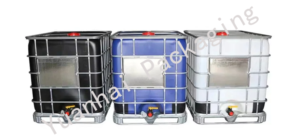The pallets of IBC containers are all-steel, steel-plastic, steel-wood, all-plastic, and all-wood. The pallet mainly consists of chassis, pads, and connecting plates (tubes).
1. Good impact resistance
A simple chassis is a flat plate design consisting of one or several plates. It can only carry the load of the container in the vertical direction, but it does not work to reduce the impact force in the horizontal direction. Here, a pallet is designed. The advantage of this pallet is that it has good strength both under strong vibration of liquid cargo in the container and vibration of the vehicle, as well as under shock and impact conditions.
2. Strong load-bearing capacity
The bottom of the integral chassis that matches the bottom of the discharge stream of the content container is designed as a self-supporting structure, and the bottoms of these reinforcement bars are on a common horizontal plane. The stiffness of the steel chassis is greatly increased by pressing out the reinforcement bars on the steel chassis, and the load-bearing capacity is greatly increased.
3. With extension and support effects.
A shallow chassis having a downwardly extending outer support edge connected to a flat bottom or lower frame at the reinforcing member portion and the support edge portion to form a cavity bottom with a closed or open cavity and a hollow support flange around the exterior, the chassis is secured to the corners of a metal support or wood pallet with the bottom at the feet and intermediate legs. A belt edge curved from the downwardly extending outer support edge supports and secures the metal frame.
Then, you will know which kind of IBC container pallet you choose

.
IBC Container wall thickness can jeopardize strength against compression
A good IBC container is a quality standardized IBC container; the first point is that the wall thickness is proportional. IBC container with at least a wall thickness of 1.6 mm. Natural IBC container thickness is unlikely to be completely proportional, but the difference is not large and basically can be counted as proportional. The proportionate thickness is the strong support of the compressive strength of the IBC container, so the big customers need to be able to test the thickness of the sold IBC container and take this opportunity to make clear whether it is up to the standard IBC container.




